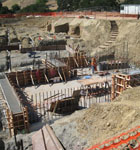1. Survey your project
A selective demolition can be done on everything from small residential units to large-scale commercial buildings. Although the demands and fine-tuning of each demolition process are contingent on the structure itself, Snover says, “the same steps for selective demolition apply to projects large and small.” The process always begins with a survey identifying hazardous materials and quantifying recyclable materials. “Once the numbers have been assessed,” Snover says, “you establish your clearances and start on your project.”
2. Choose your team
Demolition takes more than a crane and a lead ball. Especially in this age of sustainability, the best demolition is a “clean” demolition—one which repurposes all recyclable materials while having the least environmental impact possible during and after the process. “When it comes to larger projects,” Snover says, “the process usually begins by consulting with an architect to help plan out the demolition.” DMC Consultants’ recent selective demolition of the 433,000-square-foot Detroit MGM Casino began this way; Snover says special preparatory attention was required for a project of that scale.
3. Cut and cap
“Once you’ve determined your plan of attack,” Snover says, “that’s when it’s time to send in the mechanics, electricians, and plumbers.” In most cases, a building slotted for selective demolition is still a ‘live’ building, which means that the main operative functions of the structure need to be “cut and capped” to ensure a safe demolition process and to prep materials for removal and recycling, if possible. The electrician will limit or cut off power to the area chosen for demolition, the mechanic will shut down the HVAC systems, and the plumbers will cap open piping. “If the project is large enough,” Snover says, “you may also need to shut down utilities entirely.”
4. Install temporary lighting
“Depending on the window and natural-lighting situation, you generally need to install a temporary lighting system, at least in the middle sections of the structure, in order to provide visibility for the demolition team,” Snover says. Though this is a minor step, it is essential in facilitating the fluidity of the demolition process, and it also lays practical ground for the transition to step 5.
 5. Establish an egress
5. Establish an egress
Because selective demolition is meant to offset demolition costs and repurpose structural materials, an egress strategy is necessary for maximizing the collection of salable recyclable goods. Occasionally, selective demolitions will be implemented in occupied buildings, in which case, Snover says, “You will need to seal off areas or construct a trash chute [seen left] on the outside of a building, which empties into a dumpster for sorting and recycling.”
6. Pick and pack
“Once you have established the preliminaries,” Snover says, “the next step is to send in the labor contractors.” Because DMC Consultants prioritizes green demolition practices, it selects labor contractors who, during the demolition process, will presort demolished materials [seen below] for recycling and scrap valuation. “For green projects, you generally quantify these sorted materials by poundage,” Snover says, “which allows you to properly assess the effectiveness of this method.” Metal wiring, piping, and concrete can all be recycled to offset demolition costs.

7. Strip to the shell
“The labor force is going to dismantle the architectural, mechanical, and electrical elements of the target structure, which leaves you with the shell of the building,” Snover says. If the selective demolition calls for an additional structural demolition, he adds, “We will meet with and hire a team of carpenters and steel workers who are knowledgeable enough to identify and remove all superfluous structural elements.”
8. Shore up the structure
Once a structure has been stripped down to its rudimentary supports (as seen below), the selective demolition team will ‘shore up’ the structure, bolstering the shell. Key elements are sold, recycled, or repurposed, and all nonrecyclable materials are diverted to the landfill. “At this point,” Snover says, “the selective demolition is complete, and the structure is ready for remodeling.” ABQ
 5. Establish an egress
5. Establish an egress

